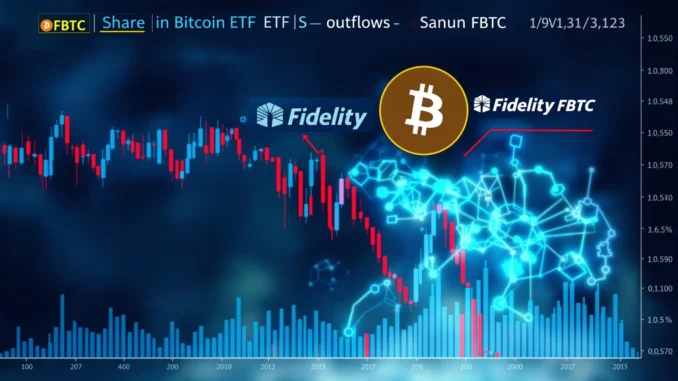
Hold onto your hats, crypto enthusiasts! The Bitcoin ETF landscape just witnessed a seismic shift. Fidelity’s spot Bitcoin ETF, FBTC, has just experienced a jaw-dropping event – a massive net outflow of $344.7 million on February 25th. This isn’t just a dip; it’s the largest single-day outflow since FBTC’s inception. What does this mean for the king of crypto and the burgeoning world of Bitcoin ETFs? Let’s dive into the details of this unprecedented event and what it could signal for the future of digital asset investments.
Why is the Fidelity ETF FBTC Experiencing Such a Significant Outflow?
The numbers are stark. On February 25th, Fidelity’s FBTC saw a staggering $344.7 million exit the fund. To put this into perspective, this single day surpasses any previous outflow FBTC has recorded. Data from Farside Investors paints a clear picture: investors are pulling capital out of Fidelity’s Bitcoin ETF at an unprecedented rate. While we await complete data on other major players like BlackRock’s IBIT and ARK Invest’s ARKB, this news from Fidelity raises some crucial questions:
- Profit Taking? Could this be a wave of investors cashing in profits after the recent Bitcoin price surge? The market has been bullish, and some might be locking in gains.
- Market Correction Fears? Is this a sign of growing unease about a potential market correction? Large outflows could indicate investors are becoming risk-averse and moving assets.
- Rotation to Other ETFs? Are investors shifting their funds to other Bitcoin ETFs, perhaps seeking lower fees or different investment strategies? We need to analyze the flows of competing ETFs to understand this better.
- External Market Factors? Could broader economic news or global events be influencing investor sentiment and prompting this outflow from the Fidelity ETF?
Understanding the ‘why’ behind this **Fidelity ETF** outflow is crucial for gauging the overall health and direction of the Bitcoin ETF market.
Decoding the Impact of Bitcoin ETF Outflows on Bitcoin Price
The cryptocurrency market is known for its volatility, and news like this can send ripples. A significant outflow from a major **Bitcoin ETF** like FBTC can exert downward pressure on the Bitcoin price. Here’s how:
- Reduced Demand: Outflows mean less capital is flowing into the ETF, which in turn can reduce the demand for Bitcoin itself, as ETFs hold actual Bitcoin.
- Market Sentiment: Large outflows can negatively impact market sentiment. It might be interpreted as a lack of confidence in Bitcoin or the crypto market in general, leading to further selling pressure.
- Price Fluctuations: While a single day’s outflow may not cause a dramatic crash, sustained outflows can contribute to price volatility and potentially a downward trend.
However, it’s important to remember that the **Bitcoin price** is influenced by a multitude of factors, not just ETF flows. Macroeconomic conditions, regulatory news, and overall market sentiment all play a significant role.
Is This a Broader Crypto ETF Outflow Trend or an Isolated FBTC Event?
While the $344.7 million **FBTC outflow** is undoubtedly headline-grabbing, we need to zoom out and consider the bigger picture. Is this an isolated incident specific to Fidelity, or are we seeing a wider trend of **Crypto ETF outflow** across the board? Here’s what we need to consider:
| Factor | Isolated FBTC Event | Broader Crypto ETF Outflow |
|---|---|---|
| Data from Other ETFs (IBIT, ARKB) | If other ETFs show inflows or minimal outflows, it suggests FBTC issue. | If other ETFs also show significant outflows, it indicates a wider market trend. |
| Fidelity Specific Issues | Could be related to Fidelity’s platform, fees, or specific investor base. | Less likely to be a factor if other ETF providers are seeing similar outflows. |
| Market-Wide Sentiment Shift | Less likely to be the sole cause if isolated to one ETF. | More likely to be a cause if multiple ETFs experience outflows simultaneously. |
The coming days will be crucial to analyze data from other **Crypto ETF** providers to determine if this is a systemic shift or a specific issue impacting Fidelity. Investors should monitor the flows of IBIT, ARKB, and other Bitcoin ETFs to get a clearer understanding of the overall trend.
Navigating the Future: What Does This Mean for Bitcoin and Institutional Investment?
The cryptocurrency market is still relatively young, and the ETF landscape is even newer. Events like this **FBTC outflow** serve as important learning points for both investors and the industry. Here are some key takeaways and considerations:
- Volatility is Inherent: Crypto ETFs, while offering regulated access to Bitcoin, are still subject to the inherent volatility of the underlying asset.
- Diversification is Key: Don’t put all your eggs in one basket. Diversify your crypto investments and your overall portfolio.
- Monitor ETF Flows: Pay attention to ETF flow data as it can provide insights into market sentiment and potential price movements.
- Long-Term Perspective: Crypto investing, especially in Bitcoin, is often viewed as a long-term play. Short-term outflows may be noise in the bigger picture.
- Institutional Investment is Evolving: The institutional embrace of Bitcoin via ETFs is still in its early stages. Expect fluctuations and adjustments as the market matures.
In conclusion, Fidelity’s record **Bitcoin ETF** outflow is a significant event that warrants attention. While it may raise eyebrows and trigger short-term market jitters, it’s crucial to analyze it within the broader context of the evolving crypto ETF market and the ever-dynamic world of Bitcoin. Keep your eyes peeled for further data and analysis as we navigate this fascinating and often unpredictable landscape of digital asset investment.



